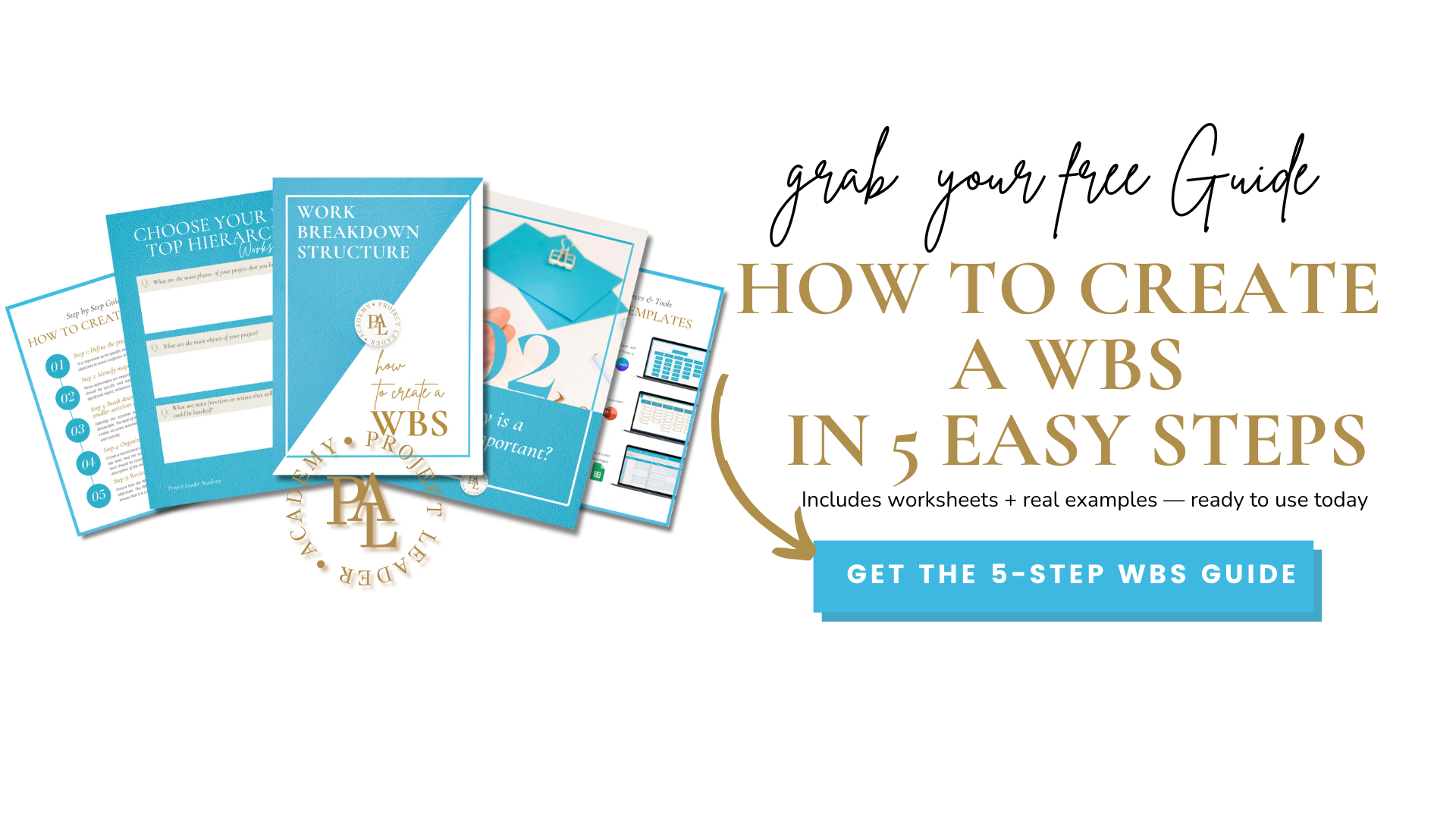How to Create a Work Breakdown Structure in 5 Steps

Before you plan timelines, budgets, or resources, you need one thing:a Work Breakdown Structure that shows exactly what needs to be done.
If you feel you do not know where to start, how to get things done. how much time and money you will need to accomplish a project, then this WBS exercise is for you.
You do not need any complicated studies but the following project management Jargon will help you to ask professional experts to visualize their work so that you can understand the budget and the resources they claim to accomplish the work.
Learn the step-by-step process to create a Work Breakdown Structure (WBS) for your project. Improve timeline, budget, and project success.
Download the WBS Guide + Templates (Free)
Whether you are a solopreneur or big boss who is hiring experts , you need to know the following about the WBS.
1. What is a Work Breakdown Structure (WBS)?
The WBS - the work Breakdown Structure defines the “what” you need to accomplish in order to achieve the objectives of the project. The WBS is a single easy to understanding chart The purpose of a WBS is to break down complex activities into smaller manageable pieces- so-called deliverables that you can control.
- A WBS is a structured breakdown of all the project work into manageable pieces.
- A WBS is a visual structure of the scope of work.
- The WBS is the answer to the question:
“ What needs to get done in order to achieve the objectives?”
A Work Breakdown Structure is a visual tool of all tasks ( deliverables, activities, elements, work packages) that need to be done in order to achieve the project goals.
The best WBS is a visual map of the entire scope of work in a structured way.
You can think of the Work Breakdown structure as your ORS-System for your project deliverables:
O OBJECTIVES
R ROADMAP
S STRUCTURE
You can apply this by asking the following questions:
- What is the overall goal? (outcome, the project objectives, the transformation)
- What is the Roadmap? ( path process, phases)
- How do you structure your tasks, deliverables, and activities?
OBJECTIVES - deliverables need to be focused on achieving the goals so we need to know them first.
ROADMAP Do we know proven phases, a working process or steps we need to take to achieve the project goals? The project results are in the future so it makes sense to include all steps necessary to get us to the finish line from where we are enow to where we want to be.
STRUCTURE How can we structure all work packages, deliverables and activities of our project in an easy to manage way.
Let’s be honest: most projects don’t fail because of bad ideas. They fail because nobody actually knows what needs to get done — by whom, by when, and in what order.
That’s where the Work Breakdown Structure (WBS) comes in. It’s more than a task list, architect drawing or technical description— it’s your project’s navigation system. It helps you to staying on budget and focused on achieving results.
Without it, you can’t allocate resources, track progress, or even define success. With it, you get laser-sharp clarity on scope, can create a timeline, and know all deliverables — before the first euro is spent.
Your WBS -Work Breakdown Structure- is the foundation to create a Gantt chart ,the WBS can make or break your project,
- It can make or break your timelineI
- It can make or break your project budget
- It can make or break achieving your project goals.
because when you don't have a Work Breakdown Structure you cannot allocate any resources like money and time and not track any work progress.
Skipping the Work Breakdown Structure means you start your project planning without a clearly defined scope:
Be aware of that any project with an undefined scope can lead to the inclusion of unnecessary tasks and activities, leading to scope creep, delays, and budget overruns.
2. Why is the Work Breakdown Structure so important?
Projects fail when people don’t know what needs to get done. A clear WBS fixes that in minutes — not weeks.
Here are 3 typical situations why you want to create a WBS:
- Your intention is to estimate the overall project costs so you don't run out of the budget
- Your intention is to delegate work to team members or outsource work packages
- You want to be able to track work progress and make sure it is done.
You`ll need the WBS to:
- determine the resources required to accomplish each task.
- estimate the time we will need to accomplish a tasks
- show clearly to the client what is in the scope of work and what not
- hire the right experts for the tasks that need to be done in order to achieve the objectives of the project
- create a plan showing the dependencies(Pert chart) and calculating the critical path
- overview the entire scope of work
- minimize project risks
In a nutshell, the WBS is the foundation for planning the project time and budget and for tracking any work progress.
3. How to Create a Work Breakdown Structure?(WBS)
There are several ways to start a WBS — top-down from deliverables, bottom-up from collected tasks, phase-driven, or based on existing project documentation.
You’ll find all these approaches explained in detail below. What matters most is not where you start, but that you build a clear, logical hierarchy of all the work your project requires.
A simple yet powerful method to creating a WBS is keeping in mind the ORS framework:
- Objectives
- Roadmap
- Structure
To help you structure any of these methods into a clean workflow, here is a simple 5-step process you can use in every project:
Download the WBS Guide PDF (with examples & template)
The WBS in 15 min
Get some sticky notes and write all objects, and results on these sticky notes Use one note for one object. Write in capital letters so that you can later take photos and send these to an assistant to digitalize.
Now add the actions you need to do related to these objects in the past tense and create groups.
If you do have a lot of tasks in mind first start with the tasks and group them later.
Use sticky notes or a structured template to build a clear, logical hierarchy. A WBS describes what must be done — not risks, dependencies, or responsibilities.
The WBS in One hour
Do the same as in the previous exercise the WBS in 15 min but invite experts to add to the WBS their knowledge and ask your key stakeholder: What else?
In our training, we used flip charts, pinboards, and windows. However, in our online courses, we teach you how to create the same exercise online and have fun.
The 5-Step Process to Create a Work Breakdown Structure (WBS)
You can download a PDF WBS Guide here: Click here>>
Step 1: Define the project objectives
It is important to be specific and concise in defining the project objectives to avoid confusion and misinterpretation. Be clear on the overall project outcome and goals.
This is the O in our ORS system
Step 2: Identify the project's high-level phases
This is only valid if someone has been doing similar projects before. You may ask some experts to save time and not reinvent the wheel.
Here are some questions to help you get started:
- >Is there a proven roadmap to achieve the goal for such type of project or is this your very first project of a kind?
- <Do you work in sprints and see only the next milestone?
- Who has knowledge about such a type of project?
This is the R in our ORS system
Step 3: Brainstorm all activities and tasks that need to be done
Here is what you want to do if you are in doing it physically:

Get a bunch of sticky notes and
1. in the first round write just
- all the objects related to the finished product f( or a product development plan)
- or all the functions related to the service - activities (for an activity or function-oriented plan)
2. in the second round add to each object an action word in the past tense so that you create a deliverable
Object: Truck. + Function: Rent = Deliverable. Truck rented

if you want to have all deliverables in the past tense so that you can track the task is done
This WBS development process can be done easily with digital sticky notes.
We like to use Miro whiteboards without any templates.
Open the whiteboard and start creating a WBS with digital sticky notes. I like to start and invite experts to such a sticky note session.
Here is a draft of our Miro Board WBS for the Project Plan Academy

The beauty is we can all sit in our offices and create such a Work Breakdown Structure together in a team just by sharing the MIRO board link.
Additionally, to teaching how to create a WBS with Miro, we provide our client's templates for creating and presenting your Work Breakdowns Structure with Google templates, Powerpoint templates and Canva templates.

Step 4: Structure your WBS
This is the S in our ORS system for creating a structure and organizing all deliverables and tasks into a structure that makes sense.
You may start with this if you know the top-down structure of your WBS
Define the 5-7 top deliverables and add all tasks that need to be done in order to create that deliverable
Breakdown all tasks into smaller tasks until you have a terminal element
Think of your WBS as a tree with a lot of branches
We like to start with a mindmap

And add all tasks and activities that we have on our sticky notes to a category.
This will help us to check if inside the WBS
- We have or not have any duplicates
- all necessary tasks, activities, and deliverables work packages are included
- The whole scope of the project is reflected
- All objectives are met
For Product development, you may consider starting with an object-oriented WBS to make sure you have all components

This is great for developing products of all kinds in the beginning to get a quick overview of all components.
For batching repeating tasks, you may try this function-oriented WBS

If you have experience and a playbook with proven sequences you may use the phase-oriented WBS and

The deliverables are always written with a noun and a verb in the past tense. You may be more specific but keep it short.
Organizing and visualizing the activities is like creating a vision board for your project.
The Visual map of our Work Breakdown structure will help us to
have a clear "vision board" of our project scope and all the tasks we need to manage,
communicate the scope of the project to clients, stakeholders, and our team
access our intuition to identify missing pieces, risks, and uncertainties
Step 5: Review and refine the WBS
Ensure that the WBS accurately reflects the project scope and objectives. The WBS should be reviewed by all stakeholders to ensure that it is comprehensive and complete.
- The WBS should be detailed enough to provide a clear understanding of what needs to be accomplished, but not so detailed that it becomes overwhelming to manage.
- In the beginning, you may want to identify the top level only and ask experts to provide the details for accomplishing the deliverables,
- In the first phase, you want to minimize the risks of underestimating the project budget
- In the second phase, you want to make sure everybody understands what is meant by being responsible for a work package
- In the third phase, you want to have a detailed plan so that you can track the work progress and the time and money spent.
4. Tips for creating a successful WBS
Here are some general tips to make sure your WBS will help you to show the real scope of work, to be manageable, and helps you to manage the budget and time, and people.
- Involve all stakeholders in the WBS creation process
- Keep the WBS simple and easy to understand
- Use a consistent numbering and naming convention for components
- Ensure that the WBS accurately reflects the project scope and objectives
- Regularly review and update the WBS to reflect changes in the project.
What is the best level of detail required for the WBS?
In different stages, of planning your WBS u will have different levels of details
Remember:
- Don't try to make the WBS for your project t perfect just start and see how your project evolves and adjust it. If you do similar projects you can use the WBS and create a playbook so that you can minimize project risks.
5. The biggest mistakes in creating a WBS
You need to know these so that you can ask the right questions when your supplier submits a WBS, especially when you are not the subject matter expert.
One of the biggest mistakes I see in creating a WBS is trying to answer so many questions at once. Like who is doing what task and when will this task be ready,. what are the dependencies, how much does each step cost, etc? Creating a WBS is a thinking process and the best results you get are by using your brain to focus on the simple question.
What needs to get done in order to achieve the project objectives, o get the desired transformation, to deliver the result?
Grab your free Guide on How to create a WBS and watch a short video here you can see the WBS live.Click here.
6. FAQ:
FAQ: Applying the Work Breakdown Structure in Real Projects
What tools can I use to create a WBS quickly?
You can build your Work Breakdown Structure using paper and sticky notes (my recommended method), or digital tools like Asana, Miro, Trello, Smartsheet, or MS Project.
But remember — the key isn’t the software. It’s clarity. Start offline to map out your ideas, then transfer your structure into your preferred tool.
You’ll find a list of my favourite WBS tools — plus direct links and examples — inside the downloadable guide.
What should NOT be included in a WBS?
A WBS never includes responsibilities, timelines, risks, dependencies, or meeting notes. Those belong in your RACI, schedule, and risk register. A WBS describes what must be done — nothing else.
How detailed should a WBS be?
Go deep enough so that each task is clear and actionable. As a rule: if a task cannot be assigned, estimated, or delivered, break it down one level further.
How do I know if my WBS is complete?
You can take your work breakdown structure and put it into ChatGPT and ask what pieces might be missing. Maybe it comes up with some suggestions.
You can ask an expert and get their opinion. You can ask people who have done similar things.
And I would definitely ask someone who has managed projects — because many project management tasks are usually missing in work breakdown structures.
On the other hand, you also want to check — maybe using AI tools — if you have any elements that appear twice in the breakdown structure, just phrased differently or placed in different areas.
Check if all deliverables contain action-oriented tasks a(noun + a verb)
Make sure there are no duplicates
Can the WBS change during the project?
Yes. A WBS is a living structure. As you refine requirements, gain clarity, or identify new tasks, you can update it — but keep the structure disciplined.
Before we go...
We hope you created a great Work Breakdown structure that you can’t wait to share with your team and other stakeholders! Just remember to:
- Pick a top-level hierarchy and break down complex tasks
- Describe your deliverables with a verb in the past tense and a noun
- Choose the best level of detail for your work packages
- Invite experts and consultants to collaborate and review
What exciting new WBS did you come up with for your business?







